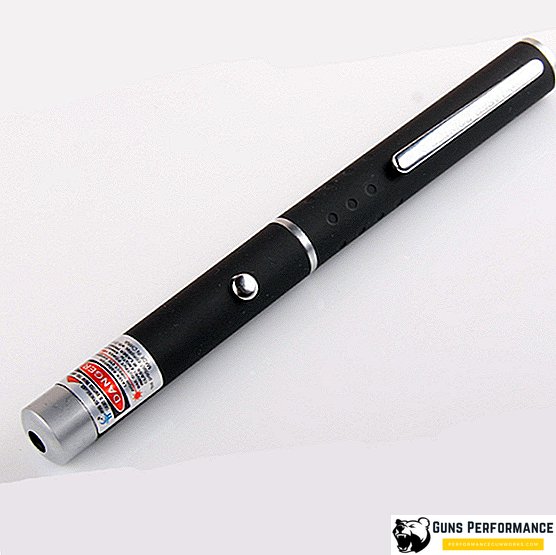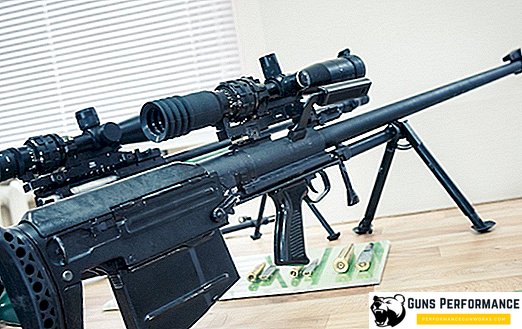Laser pointers are portable devices in which there are emitters that generate waves of electromagnetic coherent and monochromatic origin in the visible range in the radial form. Emitters can be laser diodes or high-grade solid-state lasers.

There are several types of laser pointers, which differ in types of emitters and are of such colors:
- Reds;
- Green;
- Blue;
- Turquoise;
- Blue;
- Purple;
- Yellow;
- Orange.
LU red
These LUs are the cheapest and most common. They work from a conventional tablet-type battery based on red laser diodes with an emission spectrum of 650-660 nm. They are equipped with driver power management boards. For radiation in the form of a narrow beam, lenses convex on both sides, called collimators, are used.
Red LUs are generally low-powered up to 1-100 mW. Their characteristic feature is that the red diodes pretty soon "burn through", reducing the intensity of radiation, which is why most of these pointers, after a couple of months of work, begin to shine worse, despite the charge of the batteries.
LU green (green laser)
During the day, the human eye is more sensitive to green than red (about 6-10 times). Thanks to this green laser shines more brightly. However, in the night everything happens the opposite.
Green laser diodes are extremely expensive, so solid-state lasers with diodes are used to create a green laser. They are not as expensive as green laser diodes, but more valuable than red ones. The wavelength of the green laser is 532 nm, with an efficiency of approximately 20%. Green LUs are more energy consuming than red ones; as a result, it is difficult to select units that are powered by button batteries.

LU blue
Began to be issued since 2006, the scheme of action is similar to green laser. The wavelength is blue - 490 nm, turquoise - 473 nm, and blue - 445 nm. The emitter is a solid-state high-power laser. Blue LUs are very expensive, diodes are not so expensive, but they are not widely used. Blue light emission is extremely dangerous for the eyes. Efficiency about 3%.
LU yellow
The wavelength of the yellow linacs is 593.5 nm. There are also their orange "colleagues" with a wavelength of 635 nm. Efficiency - just over 1%.
LU purple
LU with violet laser diodes have a wavelength of 400-410 nm. This is almost the limit in the range that the human eye perceives, so this light is seen as dim.
The light of violet lu causes fluorescence, and the brightness of luminous objects becomes more intense than in the laser itself. The LU series went with the advent of the drive for the optical carrier Blu-ray, which used a laser diode with a wavelength of appropriate radiation.
DR: application
- LEs are often used by educational institutions, for example for physical experiments, as well as for presentations;
- The light point that forms the laser beam attracts the attention of domestic animals. Especially cats and dogs react to them, which often leads people to play with these pets;
- Green LUs are used both in amateur and professional astronomical research. Green LUs are used to determine the directions of stars and constellations;
- LUs are used as laser targets, for precise aiming of a firearm or pneumatic weapon;
- LUs are used by radio amateurs as a communication element in visible boundaries;
- Red LUs with detached collimators are used when creating amateur holographies;
- Laboratory practice uses LU (especially green) to detect in liquids, gases, or any transparent substances in small amounts of impurities or suspensions of mechanical origin, which are invisible to the naked eye.
Laser safety
Laser radiation is dangerous when in contact with eyes.
Ordinary LUs have a capacity of 1-5 mW, they are referred to 2-3A hazard classes. They can be dangerous in the case of directing the beam into the eyes of people for quite long periods or with the help of optical devices. LU capacity of 50-300 mW is classified as class 3B. They are dangerous causing severe damage to the retina, even with short-term direct laser beam hits.
You should be aware that in the low-power green DPSS pointers, significantly more powerful IR lasers are used, which do not guarantee sufficient filtration of IR radiation. These types of radiation are not visible and as a result of this are much more dangerous to the eyes of people and animals.
In addition, LUs can have extremely annoying effects. Especially if the beam gets into the eyes of drivers or pilots, which can divert their attention or even lead to blinding. In some countries, such acts entail criminal liability. For example, in 2018, an American was sentenced to almost two years in prison for a brief blinding by a powerful laser pilot in a police helicopter.
In recent years, more and more numerous "laser incidents" have occurred in developed countries, caused by requirements to limit or ban LU. Currently, the law of New South Wales provides for a penalty for possession of the LU, and for committing a "laser attack" - a conclusion of up to 14 years.

The use of LU is prohibited by the rules during football matches. For example, the Algerian Football Federation was fined 50,000 Swiss francs for being blinded by the Russian national team goalkeeper Igor Akinfeyev with a laser pointer during the 2014 World Cup.
The most powerful laser pointer
Not so long ago it became known about the appearance of the most powerful pocket laser, the "king" LU or the "sword of the Jedi." A small, powerful laser can burn thin plastics, blow up children's balls, set fire to paper, and blind people. The device of the Chinese manufacturer Wicked Lasers only briefly resembles the popular LU, but has a larger body.
Often a laser pointer with a tiny cylinder that gives out a red laser beam is used by children for games or for school presentations. However, the Wicked Lasers index for children will not be a toy. And this is not accidental, because the output power of the Chinese laser pointer is tens and hundreds of times more significant than that of conventional low-cost LUs.
Surprisingly, the Chinese "green supermodel" with a beam power of 0.3 watts reaches "exposure range" up to 193 kilometers.












